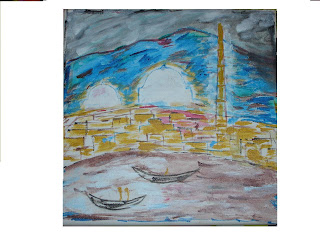A Khajuraho image from my second dip into central India. It was in October 2004. I had done a trip in central west a year before, touching Indore, Ujjaini, Bhopal & Panchamarhi (Maharashtra and Madhyapradesh). This time in 5 days or so, I did Khajuraho, Varanasi & Saranath. A journey, touching the most precious jewels in India's rich heritage and history. Actually I went to visit Varanasi, the fabled pilgrimage, the living symbol of faith, an exposition on the chakra of life and its finality in the death (or non-finality in death?). More on that on a seperate blog.

My contribution to the vast number of images published on Khajurao erotic poetry (hence a stereotyped kind, still couldnt resist publishing it).
It would be great injustice to portray that the temple site is only about eroticism. Khajuraho is a rich iconography in life of men and women, god and goddess. It has ideas and scenes from war and peace, art and dance and references to the most meditative and erotic sides of life. On the basement walls, you will see royal processions engraved with elephants, infantry and the King, then battle scenes where scores of soldiers fighting, hunting scenes with King astride on elephant and animals being pursed, domestic scenes of cooking and feeding babies, musicians on concerts, acrobats performing, festivities and ceremonies, loving couples and dieties, women in their most sensous postures and the most shocking so called 'Kamasutra' postures.
The absorbing architecture and carvings of the temples are needless to mention. The imposing Kandariya Mahadeva temple's tallest spire go upto a height of 30 meters with smaller 84 spires surrounding it. These temples are compact and tall, raised on a high platform (there was water around them in former times) with an ambulatory path around, but with no enclosure wall. Each has the essential sanctum containing the chief image, joined to the hall of worship by a vestibule. The hall is approached trough a porch; both have pyramidal towers. Larger temples have lateral transepts and balconied windows, an internal ambulatory and subsidiary shrines. On the walls are the major sculptures of gods and goddesses in two rows, with celestial nymphs in attendance on the raised sections and loving couples in the recesses. All the figures are resting their weight on one leg, thus accentuating their curves. The nymphs shown attending to their toilet, bearing offerings, dancing, playing musical instruments or as sensual lovers, are executed with great skill.
There are some 25 temples surviving (believed that there were about 85 temples). The temples were built by Chandela kings from mid- 9th century to early 12th century. There is no explanation for chosing Khajuraho as the temple site, which is supposed to be so remote to any cultural centre or major city even in 9th century. However The temple site was abandoned when the dynasty moved into forts to defend the invading muslim armies. It was forgotten to become a den of tigers till it was re discovered by Captain TS Burt in 1938.
You will see temples dedicated to Shiva, Vishnu, Surya gods. Some believe these temples to be centers of tantrik mysticism, which regards sex as an important part of human development and the attainment of the Absolute. Others believe that they were constructed as such to lure men and women back to the family and worldly life, which play an important part in Hinduism, from the austerities preached by the Buddha that were gaining favor with people of that time.
Whatever be the motivation its a celebration of life, a rather unrestrained one.






















